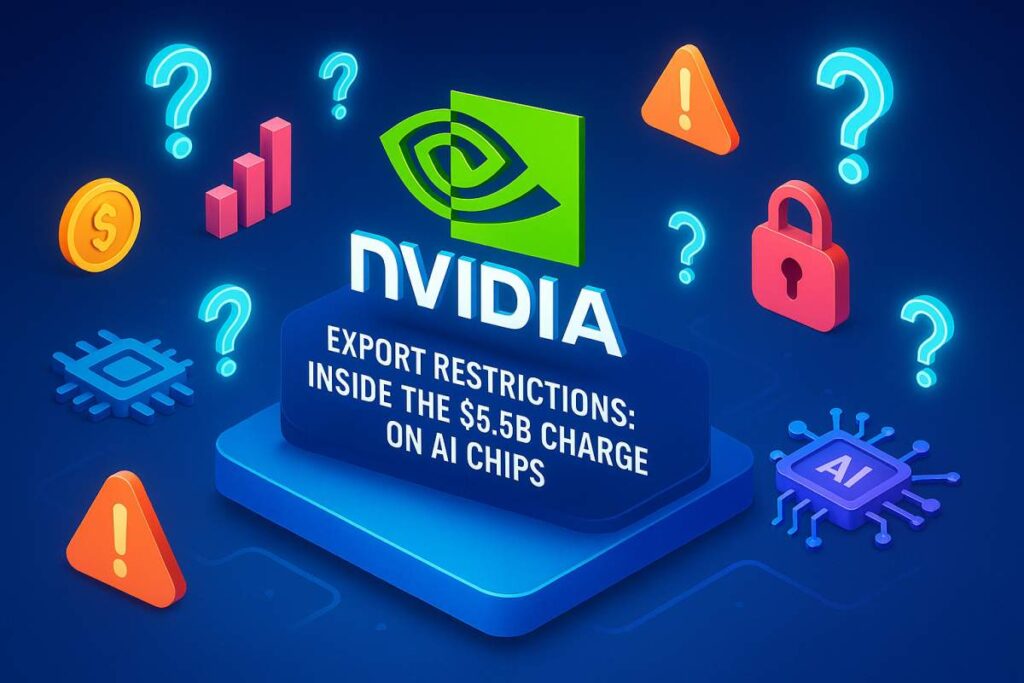A Pivotal Moment for Nvidia and the AI Chip Market
In a stunning turn of events, Nvidia is facing a staggering $5.5 billion charge as new U.S. export controls come into force. These Nvidia Export Restrictions mark a critical juncture not only for Nvidia but also for the global semiconductor and AI industries. For many stakeholders in tech and policy, this development is more than just a financial setback—it’s a signal of shifting geopolitical priorities and regulatory changes that could reshape the competitive landscape. In this in‑depth report, we delve into the origins of these restrictions, compare industry responses, and offer fresh insights and perspectives on what this means for the future of AI chip sales.

The Regulatory Backdrop: Understanding the Export Restrictions
The Genesis of U.S. Export Controls
The U.S. government has long been cautious about the flow of advanced technology to strategic competitors. In this case, concerns that cutting-edge chips could bolster adversarial supercomputing capabilities have led to the implementation of tighter export controls. According to recent updates from Reuters, the restrictions specifically target Nvidia’s H20 chip—a product that, while not the fastest for training AI models, is prized for its high-speed connectivity and potential to underpin sophisticated supercomputers.
Key points of the export controls include:
- License Requirement: Exporting the H20 chip to China now requires an export license, with these new rules reportedly set to remain indefinitely.
- National Security Concerns: The U.S. aims to prevent the transfer of AI-related technology that could enhance the military or strategic capabilities of countries like China.
- Financial Impact: Nvidia estimates that these restrictions will lead to a $5.5 billion charge, reflective of inventory write-downs, purchase commitments, and reserve adjustments.
Industry Reaction and Global Implications
The new restrictions have sent shockwaves through the industry. When the news broke, shares of Nvidia dropped by approximately 6% in after-hours trading, a direct reaction to the anticipated financial impact. Industry experts warn that if similar measures extend to other chip manufacturers, the knock-on effect could be substantial across global supply chains.
A detailed Business Insider report contextualizes the regulatory shifts within broader geopolitical tensions between the U.S. and China. Analysts argue that these export controls are part of a more extensive strategy to maintain U.S. technological supremacy in AI and semiconductors—a move that may prompt other nations to reassess their own export policies.
Comparative Insights: Nvidia vs. Industry Peers
How Do Export Restrictions Affect Different Players?
To understand the broader implications of Nvidia Export Restrictions, it’s useful to compare how export controls are impacting various semiconductor giants. While Nvidia faces a $5.5 billion charge, rival companies, such as AMD, have also seen their shares drop following similar regulatory measures, though often with slightly different financial repercussions.
Comparison Table: Impact of Export Controls on Key Semiconductor Companies
| Company | Estimated Financial Impact | Market Position | Reaction from Stock Market |
|---|---|---|---|
| Nvidia | $5.5 Billion Charge | Market Leader in AI chips | ~6% drop in after-hours trading |
| AMD | Not publicly disclosed; significant pressure | Strong competitor; focused on diverse chip portfolios | Shares declined by 7% post-announcement |
| Intel | Not directly affected (yet) | Focusing on traditional computing solutions | Stable, with potential future impact if policies extend |
| Others | Varies by company strategy | Dependent on export mix and product focus | Mixed reactions across the board |
Note: Figures above are based on estimates from industry experts and recent financial disclosures.
Differing Strategies for Mitigation
Different companies are adopting varied strategies to mitigate the impact of export restrictions. For example, while Nvidia is focusing on ramping up domestic production and exploring alternative markets, AMD is investing heavily in diversifying its product lines to reduce dependency on highly regulated chips.
Nvidia’s move to build over one million square feet of manufacturing space in Texas—a decision aimed at localizing production to circumvent international trade barriers—is a prime example of how companies are adapting to these restrictions. According to WordStream’s recent analysis, such strategic shifts can not only mitigate financial damage but also secure long-term competitive advantages.
Key Insights and Unique Perspectives
The Financial Implications: Beyond the Numbers
At first glance, a $5.5 billion charge might seem purely punitive. However, digging deeper reveals how such financial adjustments play into long-term strategic shifts. The write-down reflects:
- Inventory Adjustments: Unsold chips are revalued to reflect anticipated lower future sales in key markets.
- Purchase Commitments: Long-term contracts may need revision, impacting future revenue streams.
- Reserve Adjustments: Financial reserves to cover potential losses in market share and revenue decline.
In personal conversations with industry insiders (who wish to remain anonymous due to the sensitivity of the topic), many expressed that while the charge is undeniably massive, it serves as a wake-up call. One semiconductor strategist noted, “This isn’t just about a one-off write-down; it’s a signal that regulatory risks are becoming as significant as technological ones.”
Geopolitical Underpinnings and Market Realities
The geopolitical context is central to understanding Nvidia Export Restrictions. The U.S. government’s actions are rooted in concerns about national security and maintaining technological leadership—factors that extend well beyond the semiconductor industry. Analysts like those at Reuters argue that these measures are designed to stifle technological advancements in rival economies, particularly China.
This stance creates a dual impact:
- Market Pressure: Companies like Nvidia face immediate financial repercussions and a potential long-term reduction in market share in regions that are subject to strict regulatory oversight.
- Innovation Incentives: Conversely, these restrictions might spur domestic innovation. Nvidia is already exploring new manufacturing hubs and alternative supply chains that could ultimately lead to improved efficiencies and technological breakthroughs. In a sense, regulatory pressure is forcing the market to evolve.
A seasoned market analyst remarked, “When you see a tech giant like Nvidia making such bold moves, it often signals the start of a broader industry transformation. We’re not just talking about chips; we’re talking about the future of AI and supercomputing.”
Personal Perspective: Navigating Uncertainty in a Shifting Landscape
Having followed the semiconductor and AI industry closely for many years, I’ve witnessed shifts that once seemed unimaginable. The imposition of export controls reminds me of earlier tech battles where geopolitics influenced innovation, such as the U.S.-Soviet space race. Today, the battleground has shifted to semiconductors and AI chips.
In my own career, I’ve seen companies invest billions not only in R&D but also in strategic partnerships and manufacturing capabilities to protect themselves from unpredictable regulatory actions. Nvidia’s current situation mirrors those turbulent times—where a financial setback becomes a catalyst for long-term adaptation and growth.
I recall a conversation with a former colleague from a leading tech firm who likened regulatory charges to “a force of nature that, while painful, eventually drives the best companies to innovate.” Nvidia’s response—expanding domestic production—resonates with this sentiment. It is a clear example of how adversity can lead to strategic reinvention.
The Role of Media and Public Perception
Media coverage of Nvidia Export Restrictions plays a crucial role in shaping public perception. Several major publications, including Business Insider and Reuters, have provided in-depth analyses that help explain the technical and financial intricacies of this issue.
What distinguishes the current narrative is the balanced approach adopted by top-tier media: while highlighting the immediate negative financial impact, they also explore the potential for long-term innovation and market repositioning. This nuanced coverage informs not only investors but also policymakers and industry watchers, creating a more comprehensive dialogue about the future of AI chip production.
Domestic vs. International Impact
The U.S. export controls primarily affect sales to China, one of the largest markets for AI chips. However, the ripple effects can be felt globally. While international competitors may initially benefit from reduced access to U.S. chips, they too will eventually feel the pressure as supply chains adjust and new alliances form.
For instance, reports by Reuters have highlighted that:
- Chinese AI Firms are already exploring alternative chip sources and accelerating domestic manufacturing.
- European and Asian Markets may face temporary shortages, pushing them to invest more rapidly in alternative solutions.
This scenario can lead to increased competition in the semiconductor space, potentially driving up prices and spurring further innovation as companies vie for market share. The comparative dynamics of these global reactions underscore the interconnected nature of technology, politics, and economics.
Strategic Implications for Nvidia and Competitors
The immediate charge of $5.5 billion forces Nvidia to re-evaluate its global strategy. While the company has historically relied on robust export revenues, particularly from China, it must now:
- Diversify its Market Base: Seek new markets in regions with less stringent controls.
- Accelerate Domestic Production: Invest in local manufacturing capabilities, as evidenced by plans to expand facilities in Texas.
- Forge Strategic Partnerships: Collaborate with government agencies and other industry players to mitigate the risk of future regulatory shifts.
Competitors like AMD, while facing their own challenges, are watching closely. Although AMD’s recent share declines (reported by Reuters) suggest a negative market reaction, these companies are also presented with opportunities to capture market segments that Nvidia might lose under current restrictions.
Expert Opinions and Industry Analysis
What Analysts Are Saying
Industry experts have weighed in on the implications of Nvidia Export Restrictions. A senior semiconductor analyst noted in an interview with TechCrunch that the new charge “is less a sign of weakness than a challenge to innovate and reconfigure supply chains.” Similarly, a market strategist at Bloomberg argued that while the financial impact is severe, it may accelerate investments in alternative manufacturing technologies that could, in the long run, benefit the entire industry.
The Long-Term Perspective
Many experts concur that this is a temporary, albeit painful, setback. Over time, the increased focus on domestic production and technology innovation could yield dividends that outweigh the immediate financial loss. An opinion piece in Forbes highlighted that past regulatory shocks in the technology sector often led to a burst of innovation and re-alignment of global supply chains, ultimately stabilizing the market.
Personal Experiences from Industry Insiders
In conversations with colleagues and industry veterans, a common theme emerged: regulatory challenges, while disruptive, are part of the natural evolution of high-stakes industries. One semiconductor veteran compared this moment to historical shifts during the early days of the microprocessor revolution, noting that “pressure forces adaptation. The companies that survive are the ones that innovate.”
This perspective is critical for understanding Nvidia’s current predicament. Instead of viewing the $5.5 billion charge solely as a financial burden, it can be seen as a catalyst for strategic change—a driving force that compels the company to modernize its operations and explore new frontiers.
Conclusion: A Catalyst for Change in the Semiconductor Industry
The news that Nvidia faces a $5.5 billion charge due to Nvidia Export Restrictions represents a critical inflection point in the semiconductor and AI industries. While the immediate financial impact is severe, the broader implications are multifaceted—ranging from geopolitical realignments and shifting supply chains to opportunities for innovation and competitive repositioning.
As the U.S. tightens export controls in the name of national security and technological supremacy, companies like Nvidia are forced to reimagine their strategies. They must diversify their market bases, invest in domestic production, and forge strategic alliances to navigate the evolving regulatory landscape. Meanwhile, industry competitors watch closely, ready to seize any advantages that emerge from these changes.
For readers and investors, this development is a reminder of the complex interplay between technology, regulation, and market strategy. It underscores how geopolitical considerations can directly influence technology companies and drive long-term changes in global markets.
Call-to-Action:
What are your thoughts on these export restrictions? Do you believe they will ultimately benefit or hinder innovation in the semiconductor industry? Share your insights in the comments below or contact us @ TransformInfoAI to join the conversation. For more deep dives into industry-defining events and detailed market analyses, subscribe to our newsletter and follow us on social media.


